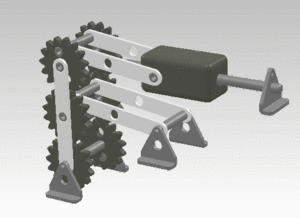Reciprocating motion


Reciprocating motion, also called reciprocation, is a repetitive up-and-down or back-and-forth linear motion. It is found in a wide range of mechanisms, including reciprocating engines and pumps. The two opposite motions that comprise a single reciprocation cycle are called strokes.
A crank can be used to convert circular motion into reciprocating motion, or conversely turn reciprocating motion into circular motion.
For example, inside an internal combustion engine (a type of reciprocating engine), the expansion of burning fuel in the cylinders periodically pushes the piston down, which, through the connecting rod, turns the crankshaft. The continuing rotation of the crankshaft drives the piston back up, ready for the next cycle. The piston moves in a reciprocating motion, which is converted into circular motion of the crankshaft, which ultimately propels the vehicle or does other useful work. The vibrations felt when the engine is running are a side effect of the reciprocating motion of the pistons, as the crank and connecting-rod usually are not enclosed.
Reciprocating motion is close to, but different from, sinusoidal simple harmonic motion. The point on the crankshaft which connects the connecting rod, rotates smoothly at a constant velocity in a circle. Thus, the horizontal displacement, of that point, is indeed exactly sinusoidal by definition. However, during the cycle, the angle of the connecting rod changes continuously. So, the horizontal displacement of the "far" end of the connecting rod (i.e., connected to the piston) differs from sinusoidal.
See also
- Oscillation
- Stroboscope an instrument used to make a cyclically moving object appear to be slow-moving, or stationary.
- Rotary reciprocation
- Reciprocating saw
- Reciprocating engine
- Rotary reciprocating saw
- Agitation
- Scotch yoke
- Crank
- Swashplate
- Trip hammer
- Slider and crank mechanism
- Straight line mechanism
- Reciprocating compressor